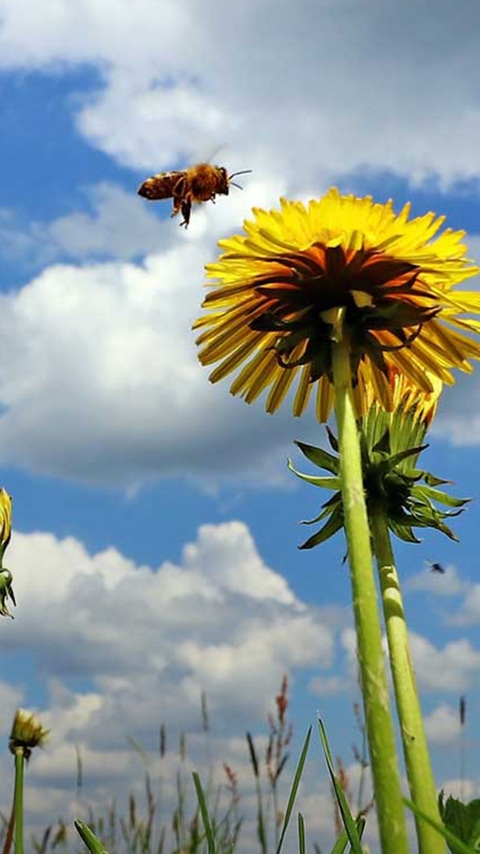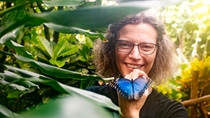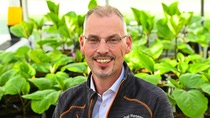Novice in mediji
A world without insects?
Recent reports have painted a bleak picture of the future for insect species and the potential consequences for the planet. We look behind the headlines to ask what causes insect populations to decline and how we should tackle this complex challenge.
No one knows for sure how many insects there are on our planet, but we do know that it’s a lot – an estimated 200 million-plus for every human on Earth. Their numbers, however, are declining. The disappearance of insects from their usual habitats has been noticed in regions around the world – whether it’s in Europe, Australia, the USA, or even in the tropical rainforests of Puerto Rico. While scientists agree that this decline is real, there is conflicting evidence about its scale and causes. Some researchers have warned that we are facing an insect Armageddon, with insects dying out entirely in 100 years if we do not take action. The United Nations Intergovernmental Science-Policy Platform on Biodiversity and Ecosystem Services (IPBES) says that the picture is not so clear, and has made a tentative estimate that 10 percent of insect species are under threat.
Over the coming pages, we asked experts in different fields about what is causing these declines – and what we can do to reverse the trend.
From different perspectives
Recent reports state that insect populations in some parts of the world are declining. We ask different experts about the facts behind the headlines, why insects matter, and what we can do to protect them better.
The vast majority of insects are out there helping our lives every day.”
Creating Chemistry: How much do we still have to discover about the insect world?
Anne Sverdrup-Thygeson: Around 75 percent of all plant and animal species on this planet are insects. That’s mind-blowing. The vast majority we have no idea about. Of those we do know, only 1 percent have been evaluated as to whether they’re threatened. There’s a lot left to discover.
Lots of insects are a nuisance or carry disease – why do we need them?
Sverdrup-Thygeson: Only a tiny fraction of insect species are bothersome. The vast majority are out there helping our lives every day. They’re involved in many ecological processes, like recycling dead organic matter, whether it’s dung, dead plants and trees, or dead animals. This is one of the basic processes of life. If nutrients aren’t recycled into new fertile soil, there is no way plants can grow. Then there is pollination. Three-quarters of our crop types are dependent on insect pollination. That includes fruits, vegetables and a lot of nuts. Without those nutrients we’d lack necessary vitamins and lose a lot of the taste and color in our food. Insects are also necessary as food for a lot of the bigger animals, such as birds.
What are the implications when a single species becomes extinct?
Sverdrup-Thygeson: If you start with a complete species-rich insect community and one species becomes extinct, usually nothing much changes. But when an ecosystem meets variations – as nature is now, in the face of climate change – a species-rich community is more robust and resilient to that sort of external pressure. I think of the natural world as a hammock that we rest in. We can pull out some threads, some species can become extinct, but at some stage the whole fabric will unravel. We really don’t want to get there.
What causes insect population declines?
Sverdrup-Thygeson: It is a mix of many things, but the main factor is as simple as humans taking up too much space and consuming too much of the nature around them. Agriculture is very land-intensive. Over the last century it has often changed these areas from places where insects found their habitat to a sort of monoculture. Then there is pesticide use, the introduction of species from other places that out-compete the local species and bring diseases and parasites, and on top of all that climate change. Of course, evolution is going on all the time and insects are adaptable creatures, but it’s really a question of whether they can keep up with these changes. We need to think about insects when we’re putting together development plans for land.
What can we do to protect insect abundance and diversity?
Sverdrup-Thygeson: Just learning more about insects and getting to know them is a start. If you have a garden, mow the lawn less often or make a wild corner. It’s about bringing natural vegetation back into where we live and into our agricultural and forested landscapes. We need to make it easier and cheaper to do the right things and make it cost to do the wrong things. It all comes back to us in the end. All these useful things that insects do are like a life insurance for us and our children and grandchildren
What are some of the most amazing things you have learnt about insects?
Sverdrup-Thygeson: There’s a rare longhorn beetle in the tropics in Asia with a color-changing structure that chemists have been able to copy. Even the common fruit fly is useful – it is ideal for research as it’s cheap, easy to keep in laboratories and has lots of offspring. We share more genes with the fruit fly than you might care to know. Fruit fly research is therefore highly relevant to humans, furthering our understanding of inheritance and early development, as well as phenomena such as insomnia and jet lag. Fruit flies have been involved in the winning of no fewer than six Nobel Prizes in medicine.

I really think that in order to create enough habitats to maintain a rich biodiversity, we need intensive agriculture.”
Viewpoint BASF: It’s all about balance
Insect habitats are under threat, which means it is vital that we find ways of producing enough food without using up more land.
The challenge we face is balancing the competing needs of producing enough food for a growing population and maintaining the rich biodiversity on which we depend. It’s a complex issue, but advances in technology mean that these needs are no longer as diametrically opposed as in the past.
There are three main drivers that cause declines in insect populations: loss of habitat and food sources, climate change and pollution of soil and water. Of these, loss of habitat is probably the biggest driver. Sustainably intensified agriculture is, in my view, one solution to address this challenge. It allows us to produce more food on less land. That leaves more land for insects.
Intensive agriculture requires specific crop-protection products and precision technology to apply these only where they are needed. In addition, we need to educate farmers in how to use crop-protection products so that there is minimum risk to the applicator and the environment, as at our Farmer Field Schools in Asia. Farmers learn that if you use the chemicals correctly, you use less of the product and save money.
Focus on the environment
The development of new crop-protection products has changed dramatically. In the past, research focused on potency toward the target insect. Today, the main question early on is what issues a new chemical compound might have for humans, bees, birds, other beneficial insects and the environment in general. Each one undergoes numerous studies that are globally regulated to prove the compounds are as safe as possible.
There has also been a dramatic reduction in the amount of crop-protection product needed. Our newest insecticides require just 10 grams per hectare. In the 1970s, a typical dose was 1 to 2 kilograms per hectare. The new insecticides also have a shorter half-life in the soil, meaning the time the compound remains in the environment has fallen dramatically.
What I find, particularly here in Europe, is that society has lost the connection to agriculture. If you do not acknowledge the need for agriculture, it’s very hard to understand why we need crop protection. Modern agriculture together with a varied diet makes a big contribution to our life expectancy and our quality of life. Crop protection helps ensure that we get fresh food that is healthy and safe, delivered to our plates every day.
Our society is concerned about the safety of plant protection products and perceives them as a big risk. However, modern crop protection products are among the most highly regulated products on earth. For me, their safety is beyond doubt. What strikes me is that with other things we use, like cars for example, we are less risk averse. I believe you have to know the benefits associated with a risk in order to make a good judgement call.
I really think that in order to create enough habitats to maintain a rich biodiversity, we need intensive agriculture. Intensifying agriculture means using all the tools that we have at our disposal, and that includes crop protection. We work closely with farmers to test biodiversity measures and demonstrate how they can go hand in hand with productive agricultural practices. That way we can create new habitats for our insects and all the animals to live and thrive.

All information about pollinators is important. It raises awareness about the need to improve the quality of our environment.”
Creating Chemistry: How do we balance the need to feed a growing population and protecting insects?
Vera Lúcia Imperatriz-Fonseca: Insects are not only a source of food for many people in the world, they also help to improve crop yields as pollinators. However, they are vulnerable to agrochemicals, changes in land use, managed landscapes and the effects of global warming. Pollinators need natural areas to reproduce and protect their eggs in order to survive. If we provide these natural areas, the crops visited by them will have more profitable yields. But the intense deforestation of recent years to create new agricultural land has left huge areas degraded and in need of restoration. We need to implement best agricultural practices from now on because pollinators are essential if we are to feed a growing population, to have larger yields in small areas, and to have a biodiversity that allows us to mitigate climate change conditions.
Is more effective cooperation needed across the different sectors?
Imperatriz-Fonseca: Yes. A lot of the private sector has aligned its corporate responsibility policies with the United Nations Sustainable Development Goals in order to improve performance and efficiency, and this has opened up good opportunities for cooperation. But the agricultural private sector needs to improve best practice for the people that manage chemical products in order to ensure they are applied correctly and in the amounts that are needed. Private sector companies can also subsidize resources for applied and innovative research on pollinator use and conservation. The Coalition of the Willing on Pollinators, initially organized by the Ministry of Economic Affairs of the Netherlands, now has 26 countries as partners. They’re encouraging local action to protect pollinators and their habitats, based on the findings of the IPBES pollinators assessment, as well as promoting national strategies and sharing innovation and lessons learned. Many non-governmental organizations are also applying biocultural research to improve local knowledge and preserve ecosystems.
Does more need to be done to ensure effective risk mitigation when using crop protection products?
Imperatriz-Fonseca: Of course, particularly in developing countries. The good practices applied in developed countries are needed everywhere. There is also local need for financial support to train technicians in best practice, and networks of companies could support applied research to solve local problems. This financial support could be designed through local research agencies and shared governance.
What action can we take at a local, national and international level?
Imperatriz-Fonseca: At a local level, citizen science programs are very useful as they help to organize information and local practices. Training children is also needed. All information about pollinators, their use and conservation, is important, as it creates a connection with nature and raises awareness about the need to improve the quality of our environment. At a national level, museums and collections are an excellent opportunity for research and modeling. We must improve our knowledge of southern hemisphere pollinators, for example, in terms of diversity, local distribution and the drivers that will affect them in the future. At the international level, integrated research exchanges and research training of young students would provide great opportunities to make sure that the next generations continue this vital work.

We need to invest more in understanding where wildlife can live alongside food production.”
Creating Chemistry: Why is biodiversity important?
Matt Shardlow: Biodiversity is essential for the healthy functioning of the planet and the continued existence of humankind. From agriculture to fisheries, climate function and soil function, all these things rely on a healthy ecosystem made up of different species, and most of the species are invertebrates – earthworms fertilizing the soil, bees pollinating the flowers, woodlice breaking down the leaves.
What impact is human activity having on insect populations?
Shardlow: The impact is massive. Many more species are declining than are increasing. One of the initial big drivers of insect declines is the conversion of land from natural habitat into agriculture that supports a vastly lower range of species. You end up with what is called an extinction overhang, meaning that some species may still be surviving on the fragment of habitat that you’ve left, but in the long term there is not enough variety and not enough robustness within that population to keep it going. Once you get to a certain level of fragmentation, individual animals are unable to move between those fragments to recolonize, so the species starts to evolve not to move at all. They become vulnerable, like island species.
What are the other causes of decline?
Shardlow: Layered on top of that are climate change and the chemicals we are producing. Agricultural use of neonicotinoid insecticides has had a huge impact on bees and other wildlife in Europe, Asia and America, but there are also other harmful chemicals that we’re putting into the countryside, from flea treatments for pets to human pharmaceuticals.
How can population declines be reversed?
Shardlow: We need to restore habitats that defragment the countryside – put back corridors of wildflower meadows where intensive agriculture has resulted in areas with insufficient wildflowers and nesting habitat for species to breed and survive. We should be making sure that there’s enough freshwater resource for wildlife as well as for humans, and that this water isn’t heavily polluted. We would like to see pesticide regulations changed to establish a marketplace in which pesticides that have small-scale use, and are specific in their action, are favored over broadscale-acting pesticides. These are the big drivers, but there are many other causes. For example, the rapid importation of invasive species through potted plants and soil being transported around the planet is a huge threat to biodiversity. If we are to be responsible stewards of the planet, we shouldn’t only be preventing environmental harm within the boundaries of our own countries – we have to make sure that we’re not exporting the harm.
How can agriculture contribute to increasing insect abundance and diversity?
Shardlow: There are various ways that agriculture can operate, whether it’s a restorative or organic approach, that have confirmed lower impacts on wildlife. In some of the more intensively farmed countries there’s evidence that putting back wild habitats not only provides more space for wildlife to thrive, you also end up with a healthier farm that produces more food. We need to invest more in understanding the techniques, skills and science around sustainable agriculture, where wildlife can live alongside food production. There are massive trends in things like no-till agriculture, multiple cropping, changing of crop rotations.
Are you optimistic that we can make these changes?
Shardlow: I’m an environmentalist so I’ve got to be optimistic, otherwise I wouldn’t keep trying to stop extinction. I think we’ve seen a huge shift in terms of the public’s attitude towards invertebrates. People are responding to the news of the declines with growing concern. It’s getting to the point where governments cannot ignore this issue.

Insect populations vary naturally, you need a long stretch of time to see the big picture.”
Creating Chemistry: Approximately how many types of insect are there?
James Bell: The short answer is, we don’t know absolutely. There are 1.2 million catalogued insect species thus far. Beyond that it’s just wild conjecture. A conservative estimate would be 5.5 million, but the truth is that while we have done a lot of work intemperate regions, we have still barely scratched the surface of places like Borneo.
How do you count insect populations?
Bell: It is not easy, particularly in environments like tropical forests where there are a lot of different habitat types, such as soil, leaf litter, herbaceous vegetation, trunks and canopies. One absolute method is to put down a quadrat to delineate a fixed area of a known size. You remove and count all the insects that you find. However, this is very labor-intensive. That’s why people use relative methods or subsampling to speed things up. For example, you put a suction device on the ground and draw up everything into a net. Within seconds you can collect large amounts of insects, but you couldn’t use this method in a forest, so timed searching, branch clipping, or fogging might be needed instead.
How do you estimate the absolute density of insects in a habitat?
Bell: You have to use several methods, each one designed to sample a particular aspect of the site per unit area. The same sized quadrat can’t easily be used to sample bare ground, where you might collect tens of insects, compared to topsoil or leaf litter, where thousands of insects could be caught. We try to balance effort against a realistic sample of the population that can be multiplied up to state absolutely how many insects are in an area. Ecology is so complex that compromises are ever-present.
The Krefeld study in Germany found recently that flying insect biomass had declined by 75 percent in just 27 years. How does this compare with your study?
Bell: The Krefeld study involved a large number of volunteers who made their data available to scientists – an excellent example of citizen science. One assumes that the volunteers went repeatedly to many sites and monitored the populations over 27 years, but most sites were visited only once, 20 were visited twice, and only one was visited regularly for four years. These were pieced together into a time series of insect biomasses. These aren’t species changes but overall sample weight changes in the insect community sampled. We work differently because we identify all aphids and larger moths to species, and many other insect groups, too. We also monitor all our sites daily and some have been running for more than 50 years. Insect populations vary naturally, so to get something meaningful you need a long stretch of time to see the big picture.
What have you observed in your study?
Bell: Our study is the world’s longest standardized time series on invertebrates. We report principally on aphids and moths. Over the long term, the overall abundance of Britain’s larger moths is declining at a rate of 28 percent. On the other hand, one-third of moth species are increasing. One example is lichen-feeding moths. Lichen is very sensitive to pollution. Clean air legislation means there is more lichen. The numbers of some of those moths have increased over 1,000 percent since the U.K. Clean Air Acts of the 1990s. So, you can find some success stories.
What about other species?
Bell: Depending on the model, estimates for aphids vary between a rise of 3 percent to a decline of 3.2 percent. That’s not very much. Looking over 50 years they’re in a steady state, accepting that in some years they’ll outbreak. In another study we looked at biomass trends, rather than numbers of individuals, at four sites. We found that one of the sites was in decline. But that was explained by the decline of one very heavy fly, the fever fly, which was biasing the samples.













